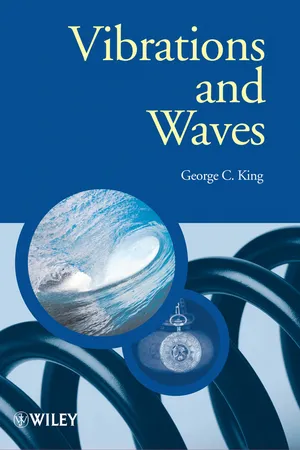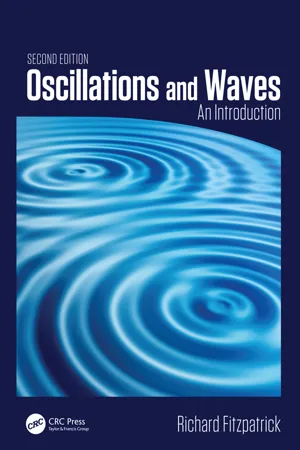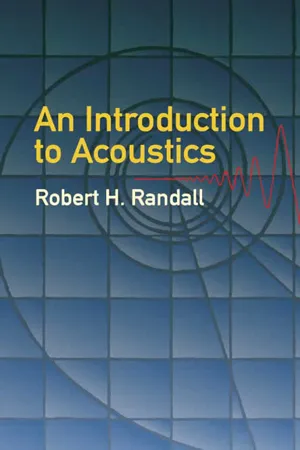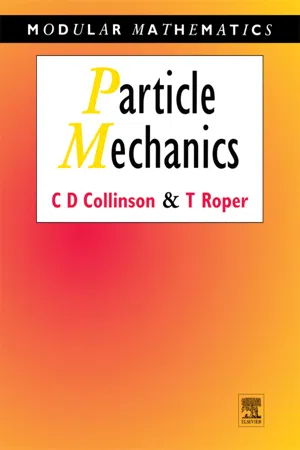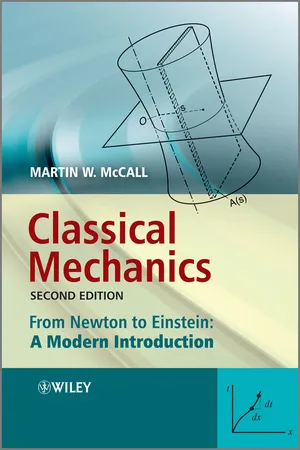Physics
Kinetic Energy in Simple Harmonic Motion
In simple harmonic motion, kinetic energy is the energy possessed by an object due to its motion. As the object oscillates back and forth, its kinetic energy varies, reaching a maximum at the equilibrium position and decreasing to zero at the extremes of the motion. This energy transformation is a key aspect of understanding the behavior of systems in simple harmonic motion.
Written by Perlego with AI-assistance
Related key terms
Related key terms
1 of 4
Related key terms
1 of 3
8 Key excerpts on "Kinetic Energy in Simple Harmonic Motion"
- eBook - ePub
- George C. King(Author)
- 2013(Publication Date)
- Wiley(Publisher)
and is also shown in the figure.Figure 1.9 The variations of kinetic energy K and potential energy U with time t for a simple harmonic oscillator. The total energy of the oscillator E is the sum of the kinetic and potential energies and remains constant with time.Figure 1.10 The variation of kinetic energy K and potential energy U with displacement x for a simple harmonic oscillator.1.2.6 The physics of small vibrations
A mass on a spring is an example of a system in stable equilibrium. When the mass moves away from its equilibrium position the restoring force pulls or pushes it back. We found that the potential energy of a mass on a spring is proportional to x 2 so that the potential energy curve has the shape of a parabola given by (cf. Figure 1.10 ). This curve has a minimum when x = 0, which corresponds to the unstretched length of the spring. The movement of the mass is constrained by the spring and the mass is said to be confined in a potential well. The parabolic shape of this potential well gives rise to SHM. Any system that is in stable equilibrium will oscillate if it is displaced from its equilibrium state. We may think of a marble in a round-bottomed bowl. When the marble is pushed to one side it rolls back and forth in the bowl. The universal importance of the harmonic oscillator is that nearly all the potential wells we encounter in physical situations have a shape that is parabolic when we are sufficiently close to the equilibrium position. Thus, most oscillating systems will oscillate with SHM when the amplitude of oscillation is small as we shall prove in a moment. This situation is illustrated in Figure 1.11 , which shows as a solid line the potential energy of a simple pendulum as a function of the angular displacement θ . (We will discuss the example of the simple pendulum in detail in Section 1.3.) Superimposed on it as a dotted line is a parabolic-shaped potential well, i.e. proportional to θ 2 . Close to the equilibrium position (θ - eBook - ePub
Oscillations and Waves
An Introduction, Second Edition
- Richard Fitzpatrick(Author)
- 2018(Publication Date)
- CRC Press(Publisher)
θ. (See Appendix B.)The kinetic energy of the system, which is the same as the kinetic energy of the mass, is writtenThe potential energy of the system, which is the same as the potential energy of the spring, takes the form (Fitzpatrick 2012)K =(1.14)1 2m=x ˙21 2ma 2ω 2sin 2(.ω t − ϕ)Hence, the total energy isU =(1.15)1 2kx 2=1 2ka 2cos 2(.ω t − ϕ)E = K + U =(1.16)1 2ka 2=1 2mω 2a 2,because m ω2 = k and sin2 θ + cos2 θ ≡ 1. According to the previous expression, the total energy is a constant of the motion, and is proportional to the amplitude squared of the oscillation. Hence, we deduce that the simple harmonic oscillation of a mass on a spring is characterized by a continual back and forth flow of energy between kinetic and potential components. The kinetic energy attains its maximum value, and the potential energy its minimum value, when the displacement is zero (i.e., when x = 0). Likewise, the potential energy attains its maximum value, and the kinetic energy its minimum value, when the displacement is maximal (i.e., when x = ±a). The minimum value of K is zero, because the system is instantaneously at rest when the displacement is maximal. The time variation of the kinetic, potential, and total energy of a mass on a spring is illustrated in Figure 1.5 .1.3 SIMPLE HARMONIC OSCILLATOR EQUATIONSuppose that a physical system possessing a single degree offreedom—that is, a system whose instantaneous state at time t is fully described by a single dependent variable, s(t)—obeys the following time evolution equation [cf., Equation (1.2) ],(1.17)s ¨+ω 2s = 0 ,FIGURE 1.5 Simple harmonic oscillation: x = a cos(ω t − ϕ). The short-dashed, long-dashed, and solid curves show K(t)/E, U(t)/E, and [K(t) + U(t)]/E, respectively.where ω - eBook - ePub
Doing Physics with Scientific Notebook
A Problem Solving Approach
- Joseph Gallant(Author)
- 2012(Publication Date)
- Wiley(Publisher)
Chapter 8Harmonic Motion
The study of Harmonic Motion, periodic motion that repeats itself at regular time intervals, is one of the most important and interesting in all of physics. Many physical systems experience such motion, and many cases are exactly solvable. Near a stable equilibrium point, the motion of any system can be approximated as harmonic motion.There are three important properties of Harmonic Motion. The period (T) is the time needed to complete one oscillation. The SI unit is the second, which is the standard metric unit of time. The frequency (f) is the number of oscillations per unit time. The SI unit of frequency is the Hertz (Hz). An oscillating object moves back-and-forth about an equilibrium point. The amplitude (A) is the object’s maximum displacement from equilibrium.It is useful to think of the period as the number of seconds-per-oscillation and the frequency as the number of oscillations-per-second, so that 1 Hz = 1 oscillation / s. As their units suggest, the period and frequency have a reciprocal relationship.(8.1)When you consider oscillations, the period tells you how long, the frequency tells you how often, and the amplitude tells you how far.Simple Harmonic Motion, Simply
Simple Harmonic Motion (SHM) is a special kind of periodic motion where the period and amplitude are constant and the period does not depend on the amplitude. SHM results when the net force acting on an object is proportional to, but in the opposite direction to the displacement from its equilibrium position. This position-dependent force, called Hooke’s Law, always pushes the object toward equilibrium.(8.2)A mass attached to a spring on a frictionless, horizontal surface provides such a linear restoring force. For this system, x is positive or negative when the spring is stretched or compressed. The positive constant k is the property of the spring (called the spring constant) that distinguishes shock absorbers (large k) from Slinkys (small k - eBook - ePub
- H. John Pain(Author)
- 2013(Publication Date)
- Wiley(Publisher)
Figure 1.4 shows the distribution of energy versus displacement for simple harmonic motion. Note that the potential energy curveis parabolic with respect to x and is symmetric about x = 0, so that energy is stored in the oscillator both when x is positive and when it is negative, e.g. a spring stores energy whether compressed or extended, as does a gas in compression or rarefaction. The kinetic energy curveis parabolic with respect to both x and . The inversion of one curve with respect to the other displays the π /2 phase difference between the displacement (related to the potential energy) and the velocity (related to the kinetic energy).For any value of the displacement x the sum of the ordinates of both curves equals the total constant energy E .Figure 1.4Parabolic representation of potential energy and kinetic energy of simple harmonic motion versus displacement. Inversion of one curve with respect to the other shows a 90° phase difference. At any displacement value the sum of the ordinates of the curves equals the total constant energy E(Problems 1.10, 1.11, 1.12)Simple Harmonic Oscillations in an Electrical System
So far we have discussed the simple harmonic motion of the mechanical and fluid systems of Figure 1.1 , chiefly in terms of the inertial mass stretching the weightless spring of stiffness s . The stiffness s of a spring defines the difficulty of stretching; the reciprocal of the stiffness, the compliance C (where s = 1/C ) defines the ease with which the spring is stretched and potential energy stored. This notation of compliance C is useful when discussing the simple harmonic oscillations of the electrical circuit of Figure 1.1(h) and Figure 1.5 , where an inductance L is connected across the plates of a capacitance C . The force equation of the mechanical and fluid examples now becomes the voltage equation (balance of voltages) of the electrical circuit, but the form and solution of the equations and the oscillatory behaviour of the systems are identical.Figure 1.5Electrical system which oscillates simple harmonically. The sum of the voltages around the circuit is given by Kirchhoff’s law as L dI/dt + q /C - No longer available |Learn more
- Robert A. Pelcovits, Joshua Farkas(Authors)
- 2023(Publication Date)
- Barrons Educational Services(Publisher)
8Simple Harmonic Motion
Learning Objectives
In this chapter, you will learn:Definition of simple harmonic motion (SHM)Physical systems exhibiting SHMDefinitions of amplitude, frequency, and periodUsing Newton’s laws or conservation of energy in SHM problemsSimple harmonic motion (SHM) is any oscillation that is governed by a linear restoring force or restoring torque such that the displacement from equilibrium can be described using sine and/or cosine functions. SHM is a special case of periodic motion, which is any oscillatory repetitive motion due to a restoring force of any form.What Is the General Mathematical Description of a Mass Connected to a Spring Oscillating on a Horizontal Frictionless Surface? We start with Hooke’s law:This is a second-order differential equation. Although you are not responsible for solving it, you should be able to see how the following two equations are solutions to this equation (you can do so by taking their derivatives and inserting them into the above equation).TIP Simple harmonic motion: a special kind of oscillatory motionYou should be aware of the following properties of these equations:■Based on the trigonometric identity sin α = cos(α − π/2), these two solutions are equivalent if φ = ϕ − π/2. Therefore, when solving problems, the choice of which equation to use is arbitrary.■There are only two parameters that completely define the spring’s motion: its position and velocity at time t = 0. These two parameters tell us everything there is to know about the system, and from them we can calculate the spring’s velocity and position at any other time. The fact that there are two physical parameters is mirrored by the fact that there are two parameters (A and φ or ϕ) apearing in x(t). This can also be explained mathematically in that two integrations are involved in moving from d2 x/dt2 to x(t - eBook - ePub
- Robert H. Randall(Author)
- 2012(Publication Date)
- Dover Publications(Publisher)
m is the maximum velocity,(1–6)At positions other than the central one and the extreme end points, the energy is partly kinetic and partly potential. The total energy of the system may obviously be taken as either the maximum potential energy or the maximum kinetic energy. Using the latter,(1–7)It is interesting to note that for particles of equal mass executing simple harmonic motions of the same energy but of different frequencies, the amplitudes must be inversely proportional to the frequency. The paper cone of a radio loudspeaker, fed with the same energy at a variety of frequencies, will have imperceptible amplitudes at the high audible frequencies, whereas at low frequencies, visible amplitudes of as much as a millimeter or two may easily occur.1- 3 Combinations of SHM’s along the same straight line.
The combination of several collinear simple harmonic vibrations may be discussed either analytically or, more conveniently, by use of the graphical method commonly employed in a.c. circuit theory. This method is fundamentally based on the rectilinear projection of uniform circular motion, so often used in elementary physics to introduce SHM. In Fig. 1–1 the length of the vector represents the amplitude of the motion, x m . The vector is conventionally assumed to rotate counterclockwise at the angular rate, ω (in radians per second). It is clear that the expression for the instantaneous projection of this vector, i.e., x m cos(ωt + α ), where α is the starting angle at t - eBook - ePub
- Chris Collinson, Tom Roper(Authors)
- 1995(Publication Date)
- Butterworth-Heinemann(Publisher)
3Simple Harmonic Motion
Discussion of the motion of a particle close to a position of stable equilibrium leads to the simple harmonic motion equation. The general solution of this equation and of other equations appearing in this Chapter is obtained by ad hoc methods. These equations are all second order linear differential equations and readers who have already studied differential equations are urged to rederive the general solutions using the standard methods which they will have learnt. The general solution of the simple harmonic motion equation is shown to represent an oscillation and the effect on this oscillation of the presence of a resisting medium is investigated under the assumption that the resistance is modelled as a Stokes’ drag. It is found that the oscillator then always tends to its equilibrium position as the time tends to infinity. This is known as damping and is modelled by the damped simple harmonic motion equation. A sinusoidal forcing term is introduced into the equation and the properties of the resulting forced damped oscillations are discussed.3.1 Motion Close to a Position of Stable Equilibrium
Positions of stable and unstable equilibrium were introduced in Section 2.5 as being points at which the potential energy V (x ) of a particle is a minimum or maximum, respectively. At such points dV /dx is necessarily zero and so the force F (x ) = −dV /dx acting on the particle is also zero. A particle placed at rest at a position of equilibrium will therefore remain at rest; the particle is then said to be in stable/unstable equilibrium.If a particle in stable equilibrium is disturbed slightly either by displacing it to a nearby position or by applying a small impulsive force to start it moving, then its subsequent motion will consist of an oscillation about the position of equilibrium. The particle will not move far from its position of stable equilibrium. By contrast a particle in unstable equilibrium will, if disturbed slightly, move right away from its position of equilibrium. - eBook - ePub
Classical Mechanics
From Newton to Einstein: A Modern Introduction
- Martin W. McCall(Author)
- 2011(Publication Date)
- Wiley(Publisher)
frequency .How are the arbitrary constants corresponding to the oscillation amplitude, A , and phase constant, ϕ , to be determined? Normally we are told two facts about the state of the body at time t = 0, namely the body’s initial position and initial velocity, which together fix A and ϕ . These facts are generally referred to as initial conditions.Let us apply these ideas with a simple example. A 2 kg mass is attached to horizontal spring and displaced 1 mm from equilibrium by a force of 5 N, and then released from rest. What is the subsequent motion?If the static extension is x 0 , then F = −kx 0 ⇒ k = 5/0.001 = 5000N m−1 . Also, ω 0 2 = k/m = 5000/2 ⇒ ω 0 = 50 rad s-1 . Now applying the initial conditions to the general solution x = A cos(ω 0 t + ϕ ):x = x 0 at t = 0 ⇒ x 0 = A cos ϕ ,= 0 at t = 0 ⇒ 0 = −ω 0 A sin(ϕ ).Between these equations we deduce that ϕ = 0 and A = x 0 so(3.7)3.5 Energy in Simple Harmonic MotionWe now examine SHM further using energy concepts. Since the restoring force is conservative, we can define a potential energy, and further, that the total mechanical energy, kinetic plus potential, is a conserved quantity. We have proved these ideas in general previously. Let us see how it all checks out for SHM.The conservative restoring force in SHM is F = −kx , which can be derived from a potential function according to −kx = −dU/dx . Hence(3.8)The total mechanical energy is therefore(3.9)The time-independence of E can be checked by substituting the general solution x (t ) from Equation (3.6 ):But ω 0 2 = k/m , so(3.10)Figure 3.3Time dependence of the kinetic and potential energy in SHM when ϕ = 0.which is constant as claimed. The kinetic energy and the potential energy are time-dependent as shown in Figure 3.3 (for ϕ = 0), but their sum representing the total energy is constant. The potential energy and the kinetic energy are exchanged four times every oscillation period, whilst the total mechanical energy (= mω 0 2 A 2 / 2) corresponds to the potential energy at maximum displacement x = A , or the kinetic energy at the equilibrium position x
Index pages curate the most relevant extracts from our library of academic textbooks. They’ve been created using an in-house natural language model (NLM), each adding context and meaning to key research topics.
Explore more topic indexes
Explore more topic indexes
1 of 6
Explore more topic indexes
1 of 4
